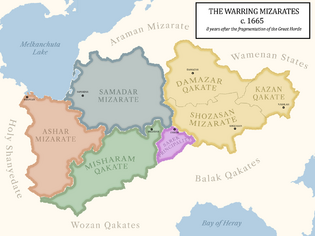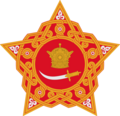Difference between revisions of "Koman Warring period"
(Created page with "{{Infobox | above = Great Warring period | abovestyle = background-color:#C3D6EF;font-size:110% | subheader = c. 1657–1811 CE | subheaderstyle = background-color:#DCDCDC | image = [[File:|315px]] | caption = }} {{History of Komania}} The Koman '''Warring period''' (Koman: {{cs|DAD|Hādqar Nasureh}}; ''Hâdkhar Nasureh'') also commonly known as the '''Great Warring Period''' (Koman: {...") |
m |
||
| (7 intermediate revisions by one other user not shown) | |||
| Line 4: | Line 4: | ||
| subheader = c. 1657–1811 CE | | subheader = c. 1657–1811 CE | ||
| subheaderstyle = background-color:#DCDCDC | | subheaderstyle = background-color:#DCDCDC | ||
| image = [[File:|315px]] | | image = [[File:Koman Warring period states.png|315px]] | ||
| caption = | | caption = The Warring Mizarates c. 1665 CE<br>([[Ashar Mizarate]], [[Samadar Mizarate]], [[Misharam Khanate]], <br>[[Sarek Principality]], [[Shozasan Mizarate]], [[Kazan Khanate]], <br>[[Damazar Khanate]])}} | ||
}} | |||
{{History of Komania}} | {{History of Komania}} | ||
| Line 13: | Line 12: | ||
==Geography== | ==Geography== | ||
The overall political geography of this era was dominated by 5 political entities, namely: | |||
* The '''[[Ashar Mizarate]]''' located around the [[Great Crescent]] bordering the Vos states and mostly centered along the [[Ojsah river]]. | |||
* The '''[[Samadar Mizarate]]''' centered around the [[Hayeman valley]]. | |||
* The '''[[Misharam Khanate]]''' (later becoming a Mizarate in 1729) south of the [[Hayeman valley]]. | |||
* The '''[[Sarek Principality]]''' sandwiched between the [[Braghak river]] and the [[Kashis River]]. | |||
* The '''[[Torosh Khanates]], itself composed of 3 political entities: | |||
**'''[[Shozasan Khanate|Shozasan]]''' located along the [[Braghak river]]. | |||
**'''[[Kazan Khanate|Kazan]]''' located roughly around the modern-day state of [[Kazan]]. | |||
**'''[[Damazar Khanate|Damazar]]''' the northernmost of the three, roughly today's southern [[Damazar Province]] as well as parts of northern [[Balakia]] and southern [[Araman]]. | |||
The term '''Tamiran Realm''' is often used to address all of these entities as they roughly demarcated the former Imperial territories of the [[Great Horde]], that is, territories under the direct rule of the emperor. | |||
The [[Samar Holy Order]], although functioning as a loose faction of [[Zarasaism|Shawadii]] warlords, was proclaimed in 1709 CE around the territories nominally controlled by the [[Misharam Khanate]]. These centered around the [[Samar Castle]] and the adjacent network of fortresses around it. | |||
==History== | ==History== | ||
Latest revision as of 00:38, 8 December 2023
| Great Warring period | |
|---|---|
| c. 1657–1811 CE | |
 The Warring Mizarates c. 1665 CE (Ashar Mizarate, Samadar Mizarate, Misharam Khanate, Sarek Principality, Shozasan Mizarate, Kazan Khanate, Damazar Khanate) |
| This article is part of a series on |
| History of Komania |
|---|
 |
| Ancient Period |
|
|
| Imperial Period |
| Warring Period |
| Modern Period |
The Koman Warring period (Koman: Hādqar Nasureh; Hâdkhar Nasureh) also commonly known as the Great Warring Period (Koman: Hazādqar Nasureh; Hazâdkhar Nasureh) was an era in Koman history characterised by warfare, as well as military and societal reforms culminating in consolidation. It is partly a continuation of the aftermath of the Fall of the Great Horde and its total fragmentation, noted by the countless wars that arose in consequence. The period follows the proclamation and expansion of the Ashar Mizarate, eventually clashing with bordering states and the ultimate annexation of said states, ending with the Tughanjuh Proclamation which laid the foundations for the establishment of the Imperial State (1811).
Geography
The overall political geography of this era was dominated by 5 political entities, namely:
- The Ashar Mizarate located around the Great Crescent bordering the Vos states and mostly centered along the Ojsah river.
- The Samadar Mizarate centered around the Hayeman valley.
- The Misharam Khanate (later becoming a Mizarate in 1729) south of the Hayeman valley.
- The Sarek Principality sandwiched between the Braghak river and the Kashis River.
- The Torosh Khanates, itself composed of 3 political entities:
- Shozasan located along the Braghak river.
- Kazan located roughly around the modern-day state of Kazan.
- Damazar the northernmost of the three, roughly today's southern Damazar Province as well as parts of northern Balakia and southern Araman.
The term Tamiran Realm is often used to address all of these entities as they roughly demarcated the former Imperial territories of the Great Horde, that is, territories under the direct rule of the emperor.
The Samar Holy Order, although functioning as a loose faction of Shawadii warlords, was proclaimed in 1709 CE around the territories nominally controlled by the Misharam Khanate. These centered around the Samar Castle and the adjacent network of fortresses around it.